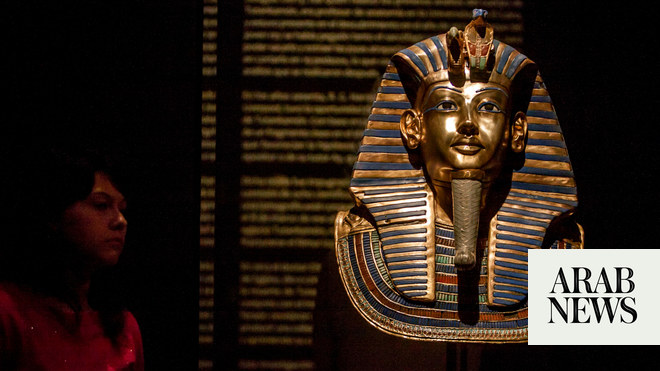
The discovery of hidden hieroglyphics within Tutankhamun’s tomb lends weight to a theory that the fabled Egyptian queen Nefertiti lies in a hidden chamber adjacent to her stepson’s burial chamber, a world-renowned British Egyptologist has said.
Nicholas Reeves, a former curator in the British Museum’s Department of Egyptian Antiquities, said that while the theory remained unproven after inconclusive radar scans, it has been given fresh impetus following the new clue.
Reeves realised that cartouches depicting Tutankhamun being buried by his pharaonic successor, Ay, had been painted over cartouches of Tutankhamun burying Nefertiti, the legendary beauty, queen of Egypt and wife of King Akhenaten.
Reeves told the Guardian: “I can now show that, under the cartouches of Ay, are cartouches of Tutankhamun himself, proving that that scene originally showed Tutankhamun burying his predecessor, Nefertiti. You would not have had that decoration in the tomb of Tutankhamun.”
On the decorated north wall, the later cartouches show Ay holding a ceremonial adze and performing the ritual of “opening the mouth” of the mummy, to restore the deceased’s five senses.
Reeves said: “Close inspection of Ay’s cartouches reveals clear, underlying traces of an earlier name – that of Tutankhamun. In its original version, this scene had shown Tutankhamun performing the funerary ritual for the tomb’s original owner, his immediate predecessor … Nefertiti.”
He added: “This conclusion finds absolute confirmation in the figures’ facial profiles – the snub nose and chubby under-chin of the [figure] currently labelled as Ay follow … precisely the standardised facial outline adopted for official representations of Tutankhamun at the very start of his kingship. The face of the mummy carries the indisputable features of Nefertiti. Demonstrably, the scene had begun its life as a record of Tutankhamun officiating at the burial of his predecessor.”
Discovered exactly a century ago by Howard Carter, Tutankhamun’s tomb was filled with chairs and chariots, among dazzling treasures the boy king would need in the afterlife.
Reeves argues that his unexpected death – in 1324BC aged 19, after only nine years on the throne – meant that he needed to be buried hurriedly: “Not until a decade later, with Tutankhamun’s death, would the tomb be reopened and its outermost elements emptied and adapted to receive its cuckoo prince.”
He said that the new evidence supports the theory that Tutankhamun’s tomb is merely the outer section of a much larger tomb “prepared for and still occupied by” Nefertiti, whose own, independent sequence of funerary chambers lie beyond what can be seen currently.
In 2015, Reeves argued that high-resolution images of Tutankhamun’s tomb showed lines underneath plastered surfaces of painted walls, suggesting unexplored doorways, although other experts felt that the scans were inconclusive.
He said: “It’s very easy just to write this off as sheer fantasy, but … I’ve discovered that the decoration of the wall in the burial chamber had been changed.
“We’ve always been puzzled by Tutankhamun’s tomb because of its strange shape. It’s very small, and not what we’d expect of a king.”
Reeves’s curatorial positions also include the Metropolitan Museum of Art in New York. He has worked extensively as an archaeologist both in and around the tomb of Tutankhamun.
He will include the new evidence in his forthcoming book, The Complete Tutankhamun, which will be published by Thames & Hudson on 28 October. It updates an acclaimed edition he first published 30 years ago, which has been in print ever since.
He argues that recent studies, including thermal imaging and mould-growth analysis, further support his case.
He writes: “Far from Tutankhamun having been buried in the expanded, unused tomb of a private individual, it looks very much as if he was merely an interloper within the outer section of a significantly larger, queenly tomb … An unusual state of affairs this may seem, but in fact the arrangement is far from unique.”
He singles out, for example, Tanis, where the 21st Dynasty burials of Psusennes I and Amenemope were discovered, intact and forgotten, behind an equivalent decorated, sliding stone partition.
He also explains that radar surveys undertaken since 2015 have been uneven: “While those reliant upon automated filtering to remove extraneous ‘noise’ have declared that they see nothing in their results, others, processing the data in a more considered manner, perceive the north wall’s eastern half to indeed be construction rather than bedrock.”
George Ballard, a leading specialist in radar and geophysical investigations of buildings and structures, is as excited by the new discovery as he is convinced that a false wall blocks an entrance to an extension of the tomb: “The evidence that we have so far does suggest that there is a man-made structure forming the north wall and the east wall of the Treasury. The east wall of the Treasury is probably natural stone that appears to have been cut or formed as a wall. There is evidence of man-made structure, although that did not seem sufficiently conclusive to some people. This is always the problem in science.
“But if there is a structure, that means somebody built it, and you don’t build things in the Valley of the Kings without an intention.”












